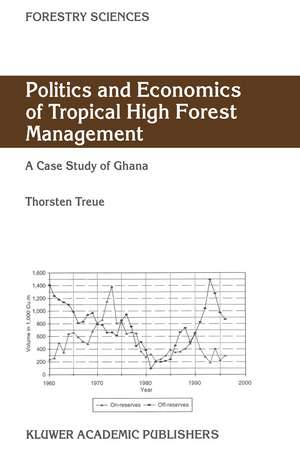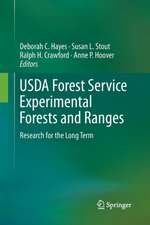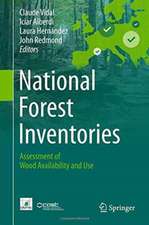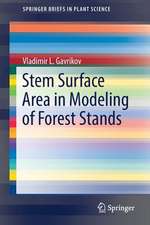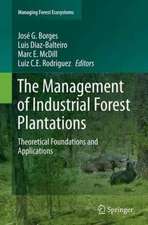Politics and Economics of Tropical High Forest Management: A case study of Ghana: Forestry Sciences, cartea 68
Autor Thorsten Treueen Limba Engleză Paperback – 25 oct 2012
Din seria Forestry Sciences
- 18%
 Preț: 958.56 lei
Preț: 958.56 lei -
 Preț: 388.13 lei
Preț: 388.13 lei - 15%
 Preț: 644.18 lei
Preț: 644.18 lei - 18%
 Preț: 1848.16 lei
Preț: 1848.16 lei - 18%
 Preț: 2105.44 lei
Preț: 2105.44 lei -
 Preț: 390.25 lei
Preț: 390.25 lei - 18%
 Preț: 950.33 lei
Preț: 950.33 lei -
 Preț: 390.84 lei
Preț: 390.84 lei - 18%
 Preț: 1226.73 lei
Preț: 1226.73 lei -
 Preț: 383.50 lei
Preț: 383.50 lei - 18%
 Preț: 950.33 lei
Preț: 950.33 lei - 18%
 Preț: 1234.77 lei
Preț: 1234.77 lei - 15%
 Preț: 637.28 lei
Preț: 637.28 lei -
 Preț: 387.58 lei
Preț: 387.58 lei -
 Preț: 385.62 lei
Preț: 385.62 lei - 18%
 Preț: 952.72 lei
Preț: 952.72 lei - 18%
 Preț: 1219.63 lei
Preț: 1219.63 lei - 18%
 Preț: 1229.73 lei
Preț: 1229.73 lei - 15%
 Preț: 647.59 lei
Preț: 647.59 lei - 18%
 Preț: 949.73 lei
Preț: 949.73 lei - 18%
 Preț: 946.10 lei
Preț: 946.10 lei - 18%
 Preț: 2762.55 lei
Preț: 2762.55 lei - 15%
 Preț: 644.95 lei
Preț: 644.95 lei - 18%
 Preț: 1840.26 lei
Preț: 1840.26 lei - 18%
 Preț: 1228.15 lei
Preț: 1228.15 lei - 18%
 Preț: 1236.69 lei
Preț: 1236.69 lei - 15%
 Preț: 639.73 lei
Preț: 639.73 lei - 18%
 Preț: 1847.21 lei
Preț: 1847.21 lei
Preț: 637.78 lei
Preț vechi: 750.33 lei
-15% Nou
Puncte Express: 957
Preț estimativ în valută:
122.06€ • 126.46$ • 101.86£
122.06€ • 126.46$ • 101.86£
Carte tipărită la comandă
Livrare economică 21 martie-04 aprilie
Preluare comenzi: 021 569.72.76
Specificații
ISBN-13: 9789401038300
ISBN-10: 9401038309
Pagini: 244
Ilustrații: XXVI, 216 p.
Dimensiuni: 160 x 240 x 13 mm
Greutate: 0.35 kg
Ediția:Softcover reprint of the original 1st ed. 2001
Editura: SPRINGER NETHERLANDS
Colecția Springer
Seria Forestry Sciences
Locul publicării:Dordrecht, Netherlands
ISBN-10: 9401038309
Pagini: 244
Ilustrații: XXVI, 216 p.
Dimensiuni: 160 x 240 x 13 mm
Greutate: 0.35 kg
Ediția:Softcover reprint of the original 1st ed. 2001
Editura: SPRINGER NETHERLANDS
Colecția Springer
Seria Forestry Sciences
Locul publicării:Dordrecht, Netherlands
Public țintă
ResearchCuprins
1 Introduction.- 1.1 Objective of the Study.- 1.2 Methodology.- 2 Brief Introduction to Ghana’s High Forest Zone.- 2.1 Forest Type and Vegetation Zones.- 2.2 Biodiversity.- 3 General Issues on Trees and Forests in the High Forest Zone.- 3.1 Functions of Trees and Forests the High Forest Zone.- 3.2 Deforestation in the High Forest Zone.- 4 The Timber Resource Base, Early Estimates.- 4.1 The Growing Stock in 1985.- 4.2 Recommendations on the Timber Harvest in 1985.- 5 National Forest Inventory (1985–89).- 5.1 Background of the Forest Inventory Project.- 5.2 Objectives of the Forest Inventory Project.- 5.3 Results of the FIP Static Timber Inventory.- 5.4 The FIP Dynamic Inventory.- 5.5 Other Technical Outputs of the FIP.- 5.6 Critique of the FIP.- 5.7 Policy Impact of the FIP.- 6 National Forest Inventory Continued (1989–97).- 6.1 Production and Protection Forest Within Forest Reserves.- 6.2 Growing Stock within Forest Reserves.- 6.3 The Sustainable Harvest Potential in Forest Reserves.- 6.4 Off-Reserve Inventory.- 7 Analysis of the Timber Harvest.- 7.1 The Log Measurement Certificate System.- 7.2 Felling Rceorded by the Forestry Department.- 7.3 This Study’s Use of Available Data on Timber Harvest.- 7.4 On- and Off-Reserve Harvest.- 7.5 On-reserve Harvest and AAC.- 7.6 Off-Reserve Timber Extraction and the Resource Base.- 7.7 Policy Implications of Extraction and Resource Data.- 8 Timber Exports and the Wood Industry.- 8.1 Development in Wood Exports by Volume.- 8.2 Apparent Domestic Consumption.- 8.3 Export as the Dominant Driving Force for Timber Harvest.- 8.4 Species Composition of the Export Harvest.- 8.5 The Value of Wood Export.- 8.6 The Hidden Costs of Value Added Wood Exports.- 8.7 Structure of the Wood Industry.- 8.8 Conclusion on Wood Exports.- 9 ForestFees and Taxes.- 9.1 Overview of Forest Fees and Related Laws.- 10 The Economies of Timber Exploitation.- 10.1 Stumpage Values.- 10.2 Domestic and FOB Log Prices.- 10.3 Estimated Stumpage Values based on Log Prices.- 10.4 Estimated Stumpage Values based on FOB Lumber Prices.- 10.5 Conclusion on Derived Stumpage Values.- 10.6 Observed Actual Willingness to Pay for Standing Timber.- 10.7. Willingness to Pay Compared with Forest Taxes and Fees.- 10.8 Commercial Value of Estimated Annual Allowable Cuts.- 10.9 Revenue from Timber Off-Reserves.- 10.10 Conclusion on the Economics of Timber Exploitation.- 11 Instruments to Regulate the Timber Harvest.- 11.1 Assessment of Employed Demand-Side Measures.- 11.2 Supply-Side Measures.- 11.3 Summary Assessment of Timber Harvest Regulations.- 12 Rights to Timber and Benefits from Timber Exploitation.- 12.1 Rights to Land, Trees and Revenue On-Reserves.- 12.2. Rights to Land, Trees and Revenue Off-Reserves.- 12.3 Principles for Allocation of Rights to Standing Timber.- 12.4 Summary Assessment of Rights to Timber and Related Benefits.- 13 Forest and Timber Resources Management in the Future.- 13.1 Development of the Timber Industry.- 13.2 A Semi-Autonomous Forest Service.- 13.3 Interests of Local People.- 13.4 Management of Forest and Timber Resources.- References.- Appendices.
